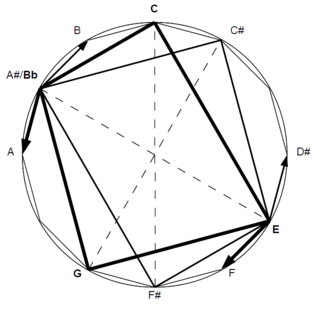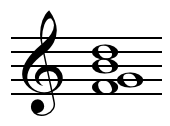Related Research Articles

Figured bass is musical notation in which numerals and symbols appear above or below a bass note. The numerals and symbols indicate intervals, chords, and non-chord tones that a musician playing piano, harpsichord, organ, or lute should play in relation to the bass note. Figured bass is closely associated with basso continuo: a historically improvised accompaniment used in almost all genres of music in the Baroque period of Classical music, though rarely in modern music. Figured bass is also known as thoroughbass.
In music theory, the minor scale is three scale patterns – the natural minor scale, the harmonic minor scale, and the melodic minor scale – mirroring the major scale, with its harmonic and melodic forms

In music performances, rhythm guitar is a technique and role that performs a combination of two functions: to provide all or part of the rhythmic pulse in conjunction with other instruments from the rhythm section ; and to provide all or part of the harmony, i.e. the chords from a song's chord progression, where a chord is a group of notes played together. Therefore, the basic technique of rhythm guitar is to hold down a series of chords with the fretting hand while strumming or fingerpicking rhythmically with the other hand. More developed rhythm techniques include arpeggios, damping, riffs, chord solos, and complex strums.
An octatonic scale is any eight-note musical scale. However, the term most often refers to the ancohemitonic symmetric scale composed of alternating whole and half steps, as shown at right. In classical theory, this symmetrical scale is commonly called the octatonic scale, although there are a total of 43 enharmonically non-equivalent, transpositionally non-equivalent eight-note sets.

A chord, in music, is any harmonic set of pitches/frequencies consisting of multiple notes that are heard as if sounding simultaneously. For many practical and theoretical purposes, arpeggios and other types of broken chords may also be considered as chords in the right musical context.
The term sixth chord refers to two different kinds of chord, the first in classical music and the second in modern popular music.
A suspended chord is a musical chord in which the third is omitted and replaced with a perfect fourth or a major second. The lack of a minor or a major third in the chord creates an open sound, while the dissonance between the fourth and fifth or second and root creates tension. When using popular-music symbols, they are indicated by the symbols "sus4" and "sus2". For example, the suspended fourth and second chords built on C (C–E–G), written as Csus4 and Csus2, have pitches C–F–G and C–D–G, respectively.
In music theory, a dominant seventh chord, or major minor seventh chord, is a seventh chord, usually built on the fifth degree of the major scale, and composed of a root, major third, perfect fifth, and minor seventh. Thus it is a major triad together with a minor seventh, denoted by the letter name of the chord root and a superscript "7". An example is the dominant seventh chord built on G, written as G7, having pitches G–B–D–F:
The diminished seventh chord is a four-note chord composed of a root note, together with a minor third, a diminished fifth, and a diminished seventh above the root:. For example, the diminished seventh chord built on B, commonly written as Bo7, has pitches B-D-F-A♭:
Coltrane changes are a harmonic progression variation using substitute chords over common jazz chord progressions. These substitution patterns were first demonstrated by jazz musician John Coltrane on the albums Bags & Trane and Cannonball Adderley Quintet in Chicago. Coltrane continued his explorations on the 1960 album Giant Steps and expanded on the substitution cycle in his compositions "Giant Steps" and "Countdown", the latter of which is a reharmonized version of Eddie Vinson's "Tune Up". The Coltrane changes are a standard advanced harmonic substitution used in jazz improvisation.

In music theory, chord substitution is the technique of using a chord in place of another in a progression of chords, or a chord progression. Much of the European classical repertoire and the vast majority of blues, jazz and rock music songs are based on chord progressions. "A chord substitution occurs when a chord is replaced by another that is made to function like the original. Usually substituted chords possess two pitches in common with the triad that they are replacing."
In music and music theory, a hexatonic scale is a scale with six pitches or notes per octave. Famous examples include the whole-tone scale, C D E F♯ G♯ A♯ C; the augmented scale, C D♯ E G A♭ B C; the Prometheus scale, C D E F♯ A B♭ C; and the blues scale, C E♭ F G♭ G B♭ C. A hexatonic scale can also be formed by stacking perfect fifths. This results in a diatonic scale with one note removed.

In music, a guitar chord is a set of notes played on a guitar. A chord's notes are often played simultaneously, but they can be played sequentially in an arpeggio. The implementation of guitar chords depends on the guitar tuning. Most guitars used in popular music have six strings with the "standard" tuning of the Spanish classical guitar, namely E–A–D–G–B–E' ; in standard tuning, the intervals present among adjacent strings are perfect fourths except for the major third (G,B). Standard tuning requires four chord-shapes for the major triads.
The harmonic minor scale is a musical scale derived from the natural minor scale, with the minor seventh degree raised by one semitone to a major seventh, creating an augmented second between the sixth and seventh degrees.
The Petrushka chord is a recurring polytonal device used in Igor Stravinsky's ballet Petrushka and in later music. These two major triads, C major and F♯ major – a tritone apart – clash, "horribly with each other", when sounded together and create a dissonant chord.
In music theory, the half-diminished seventh chord is a seventh chord composed of a root note, together with a minor third, a diminished fifth, and a minor seventh. For example, the half-diminished seventh chord built on C, commonly written as Cm7(♭5), or Cø7, has pitches C–E♭–G♭–B♭:
In music theory, Roman numeral analysis is a type of musical analysis in which chords are represented by Roman numerals. In some cases, Roman numerals denote scale degrees themselves. More commonly, however, they represent the chord whose root note is that scale degree. For instance, III denotes either the third scale degree or, more commonly, the chord built on it. Typically, uppercase Roman numerals are used to represent major chords, while lowercase Roman numerals are used to represent minor chords. However, some music theorists use upper-case Roman numerals for all chords, regardless of chord quality.

In music, the seventh factor of a chord is the note or pitch seven scale degrees above the root or tonal center. When the seventh is the bass note, or lowest note, of the expressed chord, the chord is in third inversion Play (help·info).
Musicians use various kinds of chord names and symbols in different contexts to represent musical chords. In most genres of popular music, including jazz, pop, and rock, a chord name and its corresponding symbol typically indicate one or more of the following:
- the root note,
- the chord quality,
- whether the chord is a triad, seventh chord, or an extended chord,
- any altered notes,
- any added tones, and
- the bass note if it is not the root.

Among alternative tunings for guitar, a major-thirds tuning is a regular tuning in which each interval between successive open strings is a major third. Other names for major-thirds tuning include major-third tuning, M3 tuning, all-thirds tuning, and augmented tuning. By definition, a major-third interval separates two notes that differ by exactly four semitones.